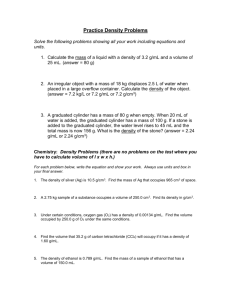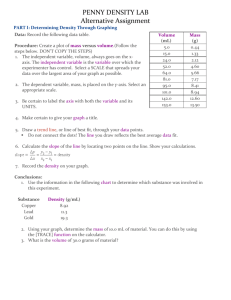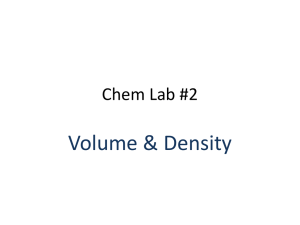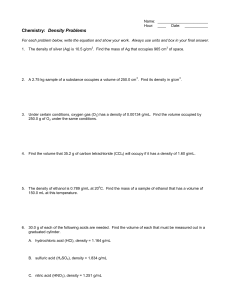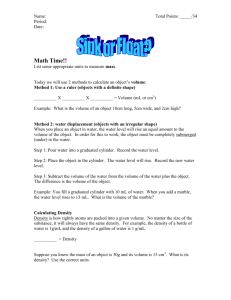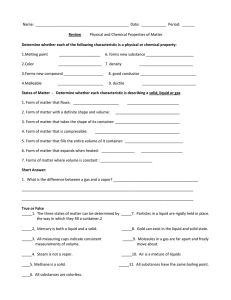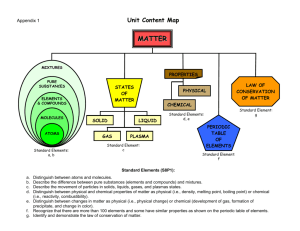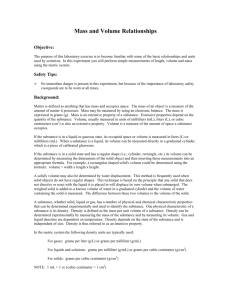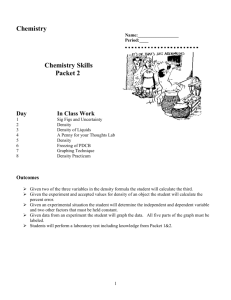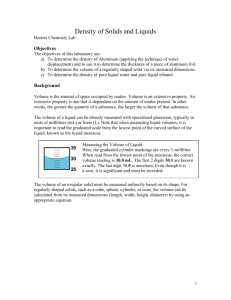Density Lab Alternative Assignment
advertisement
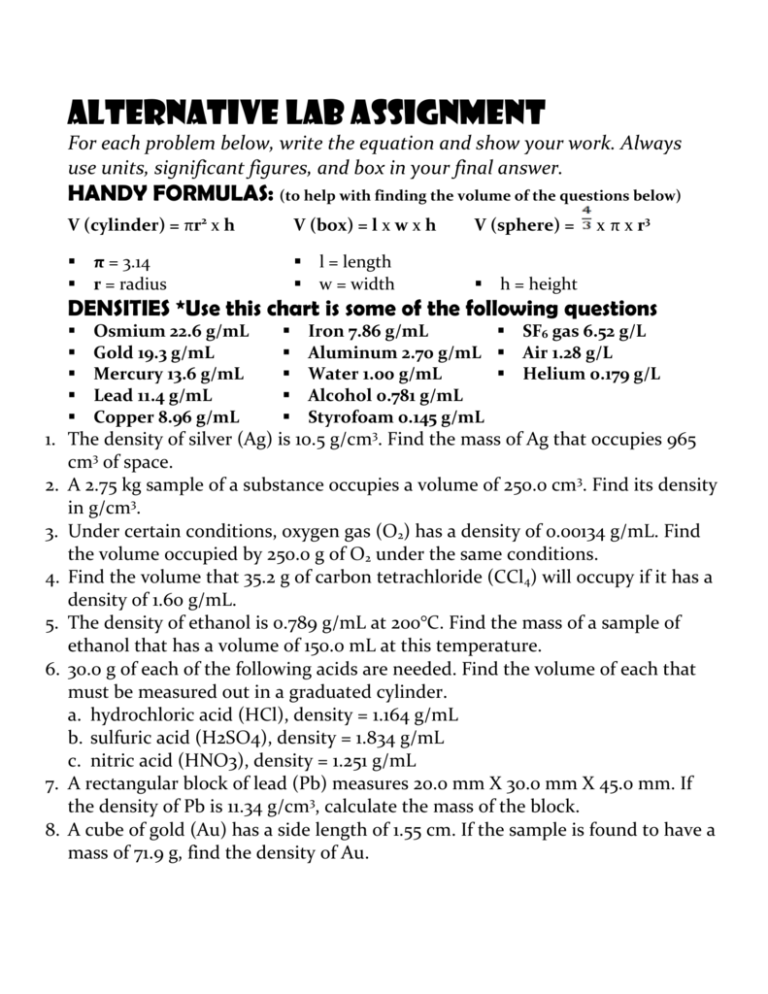
Alternative Lab Assignment For each problem below, write the equation and show your work. Always use units, significant figures, and box in your final answer. HANDY FORMULAS: (to help with finding the volume of the questions below) V (cylinder) = πr2 x h V (box) = l x w x h V (sphere) = π = 3.14 r = radius l = length w = width h = height x π x r3 DENSITIES *Use this chart is some of the following questions Osmium 22.6 g/mL Gold 19.3 g/mL Mercury 13.6 g/mL Lead 11.4 g/mL Copper 8.96 g/mL Iron 7.86 g/mL SF6 gas 6.52 g/L Aluminum 2.70 g/mL Air 1.28 g/L Water 1.00 g/mL Helium 0.179 g/L Alcohol 0.781 g/mL Styrofoam 0.145 g/mL 1. The density of silver (Ag) is 10.5 g/cm3. Find the mass of Ag that occupies 965 cm3 of space. 2. A 2.75 kg sample of a substance occupies a volume of 250.0 cm3. Find its density in g/cm3. 3. Under certain conditions, oxygen gas (O2) has a density of 0.00134 g/mL. Find the volume occupied by 250.0 g of O2 under the same conditions. 4. Find the volume that 35.2 g of carbon tetrachloride (CCl4) will occupy if it has a density of 1.60 g/mL. 5. The density of ethanol is 0.789 g/mL at 20o°C. Find the mass of a sample of ethanol that has a volume of 150.0 mL at this temperature. 6. 30.0 g of each of the following acids are needed. Find the volume of each that must be measured out in a graduated cylinder. a. hydrochloric acid (HCl), density = 1.164 g/mL b. sulfuric acid (H2SO4), density = 1.834 g/mL c. nitric acid (HNO3), density = 1.251 g/mL 7. A rectangular block of lead (Pb) measures 20.0 mm X 30.0 mm X 45.0 mm. If the density of Pb is 11.34 g/cm3, calculate the mass of the block. 8. A cube of gold (Au) has a side length of 1.55 cm. If the sample is found to have a mass of 71.9 g, find the density of Au. 9. An irregularly-shaped sample of aluminum (Al) is put on a balance and found to have a mass of 43.6 g. The student decides to use the water-displacement method to find the volume. The initial volume reading is 25.5 mL and, after the 10. Al sample is added, the water level has risen to 41.7 mL. Find the density of the Al sample in g/cm3. (Remember: 1 mL = 1 cm3.) 11. A gas has a mass of 22000 g and takes up enough space to fill a room that is 4.00 m X 4.00 m X 1.00 m. Use the table below, which lists densities in units of g/mL to help you determine what the gas is. (Hint: Change the units on the size of the room.) 12. A 30.2 mL rock weighs 56.1 g. What is its density? 13. 16.98 g of salt water has a volume of 10.0 mL. What is its density? 14. 0.121 g of hydrogen gas fills a 3.0 L bag. What is hydrogen’s density? 15. 35.2 mL of water are placed in a graduated cylinder. A 19.6 g stone is dropped in, and the water level rises to 40.1 mL. Find the stone’s density. 16. A graduated cylinder is placed on an electronic balance, and the scale reads 65.62 g. 8.0 mL of glycerine are added, and the scale reads 81.768 g. What is the density of glycerine? 17. A 3.0 cm x 4.5 cm x 6.7 cm brick has a mass of 990 g. a. What is its density? b. From what material is it most likely made? 18. A cylinder has a mass of 1128.6 g, a length of 14.2 cm, and a diameter of 2.30 cm. Of what isthe cylinder most likely made? 19. A ball has a mass of 970 g and a radius of 3.22 cm. a. Will the ball float or sink in water? b. Will it float or sink in salt water (see #13) 20.How much would a 65.1 mL chunk of Styrofoam weigh? 21.How much would a 12.1 cm x 9.6 cm x 4.3 cm block of aluminum weigh? 22. A piece of gold wire has a diameter of 0.210 cm. How much will a 2.00 km long gold wire weigh? Determining Density Through Graphing Data: Volume (mL) 5.0 15.0 24.0 52.0 64.0 81.0 95.0 101.0 142.0 153.0 Mass (g) 0.44 1.33 2.12 4.60 5.66 7.17 8.41 8.94 12.60 13.50 Procedure: PART I: Graph the data above, by creating a plot of mass versus volume. Make sure your graph included the following parts. 1. 2. 3. 4. Use graph paper. Title for graph Labels for both x & y axes, including both the variable and its UNITS. Spread your data out over both axes, so that you use all of the space available. 5. DO NOT CONNECT THE DOTS!!! Instead, draw a trend line, or line of best fit, through your data points. Make sure it starts at the origin, (0,0). PART II: Calculate the slope of the line by locating two points on the line. 6. Report the density on your graph. Conclusions: 1. Use the information in the following chart to determine which substance was involved in this experiment. Substance Copper Lead Gold Density (g/mL) 8.92 11.3 19.3 2. Using your graph, determine the mass of 10.0 mL of material. 3. What is the volume of 30.0 grams of material?


